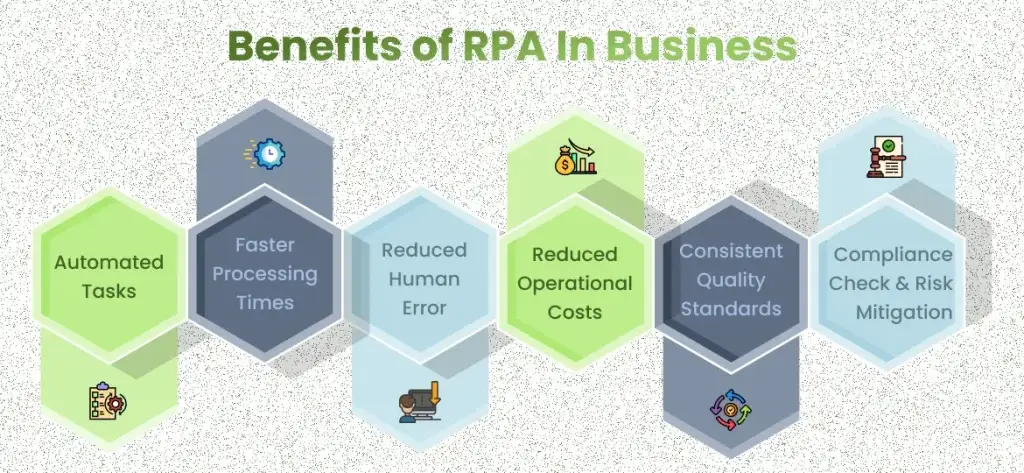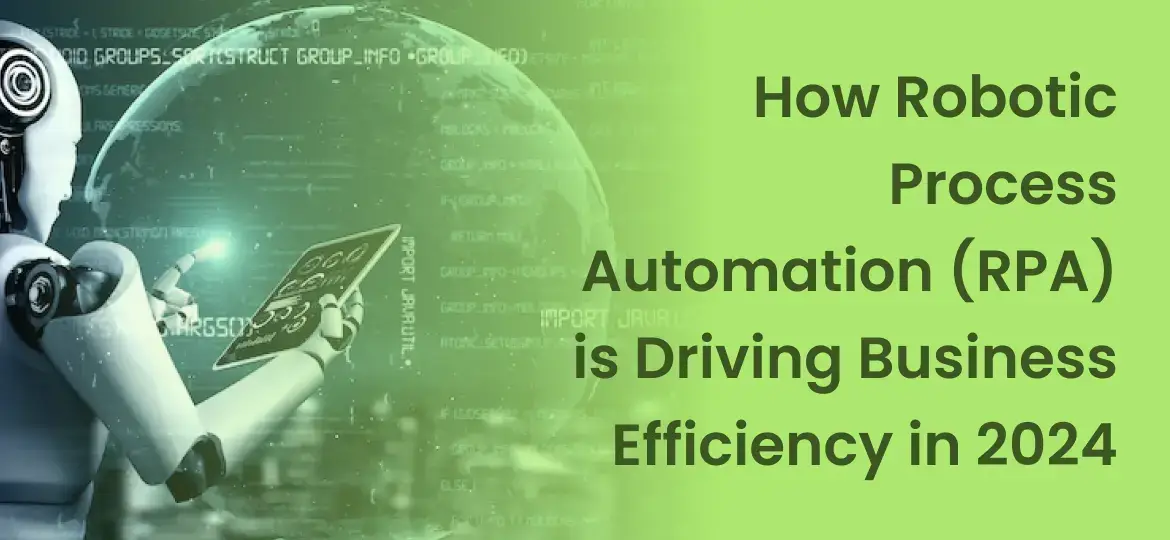Rather, the “robot” in Robotic Process Automation (RPA) refers to software robots running on a physical or virtual machine.
“RPA is a form of Business Process Automation that allows anyone to define a set of instructions for a robot or ‘bot’ to perform,” says Aaron Bultman, director of product at Nintex. “RPA bots are capable of mimicking most human-computer interactions to carry out a ton of error-free tasks, at high volume and speed.”
If that kind of automation technology sounds sort of, well, boring—especially compared to Hollywood robots—that’s by design. RPA automation services focus on streamlining repetitive and mundane computer-based tasks, enhancing workflow automation and boosting efficiency. For instance, RPA in finance can automate invoice processing, while RPA use cases in healthcare include streamlining patient data entry. Similarly, robotic automation in financial services helps with compliance and fraud detection.
Organizations leveraging AI-powered automation and intelligent RPA benefit from reduced errors and improved productivity. With advancements in hyperautomation and process automation software, the future of RPA is poised for significant growth across industries, including RPA in manufacturing and service sectors.
As businesses embrace digital transformation, RPA trends indicate an increasing demand for RPA consulting services and specialized RPA automation certification programs. Companies investing in building COE RPA (Centers of Excellence) ensure scalable automation solutions. The benefits of robotic process automation extend to cost savings, enhanced accuracy, and operational efficiency.
By integrating automation tools from a reputable RPA company, businesses can stay ahead of RPA trends 2025 and fully harness the power of industrial automation and business automation.
Imagine software that solves your repetitive tasks with ease. Not only does it finish those tasks in less time, but it also does so without any single error. Sounds fascinating. This is neither AI nor machine learning; it’s “Robotic Process Automation,” shortly known as RPA. RPA uses software robots that can replicate human behaviours to do rule-based activities across various applications.
This technology benefits high-volume procedures that require reliable, error-free execution, like data entry, invoice processing, and customer service operations. RPA in business may expect increased efficiency and innovation, paving the way for a more agile and competitive future.
Let’s understand the meaning of RPA in detail…
What is Robotic Process Automation (RPA)
Explaining and evangelizing Robotic Process Automation (RPA) outside of IT should be easier than other complex topics, such as microservices or serverless. RPA allows businesses to automate tasks and processes, simplifying repetitive work, and significantly improving efficiency. RPA intelligent automation is already transforming industries by enabling AI process automation and enhancing workflow automation.
“Businesses and organizations like RPA automation services because it helps improve productivity across a wide range of areas – users, employees, sales and marketing people, accountants, legal analysts, and more,” says Muddu Sudhakar, CEO at Aisera. RPA has several use cases in healthcare, including patient data entry, and is also being implemented in robotic automation in financial services, such as invoice processing, fraud detection, and compliance tasks. RPA in manufacturing helps streamline supply chain operations and enhance efficiency.
Still, the light bulbs usually turn on quicker with intelligent automation examples of how technology can be used in the enterprise. For instance, RPA services help improve data processing, data collection, and data correction. This is especially true in industries like financial services, where RPA in finance has revolutionized manual processes, and process automation software is now central to business operations.
Consider the vast amount of work in finance, where accounts receivable and payable traditionally require a great deal of manual effort. RPA solutions have been crucial in reducing the burden of these tasks, enhancing accuracy, and improving operational speed. Gartner predicted that 73 percent of corporate controllers would implement RPA in their finance departments by 2025, up from 19 percent in 2018.
Similarly, RPA use cases in customer service and HR streamline tedious and repetitive tasks. Businesses that implement RPA benefit from automation tools that enhance customer experience and enable citizen developers to automate processes with minimal technical expertise. With RPA automation certification and RPA consulting services, organizations are scaling their automation processes, improving efficiency, and reducing costs.
The future of RPA is brighter than ever, with RPA trends indicating continued growth in its capabilities. From hyperautomation to AI-powered automation, RPA automation services are being recognized as vital in digital transformation strategies. As companies continue to embrace business process automation and industrial automation, RPA trends 2025 highlight the need for scalable solutions to handle data-intensive, rules-based, and repetitive processes.
The term RPA was first introduced in the early 2000s by Blue Prism. Early RPA solutions were largely designed to automate simple, rule-based operations within certain applications. The technology evolved from several origins, including screen scraping, workflow automation tools, and advances in Artificial Intelligence (AI) and Machine Learning. Traditional RPA systems were simple and used to work according to certain rules, although later use of AI and ML resulted in the creation of increasingly advanced RPA systems.
Today, intelligent automation, which combines RPA with AI/ML, enables enterprises to handle complex, unstructured data and make thoughtful judgments, changing RPA from a tool for simple task automation to a digital transformation engine. Chris Huff, the chief executive officer of Kofax, has given valuable insights on how RPA can drive business efficiency in the coming years.
According to him, RPA functions as a task automation tool for a digital worker, capable of transforming rules-based repetitive work in stable environments. This ability can reduce costs, increase efficiency, and produce new revenue. In today’s quickly changing market, RPA adoption is more than a choice; it is a strategic need for organizations seeking to explore modern complexity effectively.
Types of RPA
Robotic process automation (RPA) is a powerful business process automation solution that uses software bots to handle repetitive, rule-based tasks. By automating processes such as data extraction, form filling, calculations, and system integrations, RPA improves efficiency and accuracy across business processes. Modern RPA platforms integrate seamlessly with enterprise applications, including legacy systems, ensuring streamlined operations.
A key advantage of RPA implementations is their ease of use. Most RPA tools allow users to configure workflows without coding expertise. This makes process automation RPA accessible to businesses of all sizes, from startups to large enterprises.
Enterprise-level RPA solutions are designed for scalability, security, and compliance. These RPA bots can manage thousands of tasks simultaneously while maintaining high availability and performance. While RPA technology is not inherently AI-driven, many automation companies enhance their RPA solutions with AI capabilities to expand automation use cases, improve process discovery, and optimize workflows.
- Attended RPA: Designed to assist human workers in real-time, attended RPA bots trigger automated tasks based on user inputs. This type of RPA software is widely used in customer service and IT helpdesk operations.
- Unattended RPA: Running independently, unattended RPA software executes tasks based on pre-programmed schedules or triggers. It is ideal for back-office functions such as data entry, application integrations, and IT automation.
- Hybrid RPA: A combination of attended and unattended RPA, hybrid robotic automation process apps enable seamless collaboration between human workers and RPA bots. This approach enhances efficiency in complex business processes requiring both automation and human intervention.
As robotic process automation services continue to evolve, businesses are adopting RPA and AI to enhance productivity, optimize workflows, and drive digital transformation. The right RPA software can help organizations improve operational efficiency, reduce costs, and accelerate business growth.
RPA Implementation To Drive Business Efficiency
RPA tools have a long history. From merely being a rule-based bot used for essential purposes to shifting manual work into the automated process for task completion, it is exceptionally satisfying for different kinds of businesses. So, how can you take advantage of RPA tools in 2025?
Firstly, Implementing RPA is not as simple as putting in bots; careful planning and change management are required to reap the benefits. Therefore, hiring skilled IT professionals is a must to build a powerful RPA solution for your company. Here are the simple steps one can follow:
Prioritize Your Business Goals
The first step in effectively implementing RPA is to assess existing business processes to identify potential candidates for automation. This requires finding repetitive, rule-based operations that are time-consuming, error-prone and involve significant amounts of data.
Once viable candidates have been identified, a prioritizing methodology should be implemented. Organizations can gain momentum and further support for RPA by focusing on procedures that provide early wins and demonstrate the technology’s actual value.
Create A Business Plan
Create a well-defined business plan to achieve cost savings, efficiency, accuracy, and customer experience. Other considerations include labour expenses, error costs, return on investment (ROI), and so on. Once the prospective benefits have been quantified, the business case may be presented to key stakeholders, such as senior management, IT, and business users, to get their support and funding.
Design or Develop A Solution
Once the RPA vendor and tool have been chosen, the focus switches to planning and developing the actual RPA solution. This entails establishing thorough process maps and workflows that document the specific actions involved in the automation process. These process maps serve as the foundation for the creation of RPA bots. During the development phase, RPA bots are configured to complete the desired tasks using the selected tool based on the given workflows.
Monitor And Test
Next, rigorously test and monitor your program to guarantee that the RPA bots are accurate, reliable, and aligned with business standards. This testing step identifies and addresses any potential issues before full-scale deployment. Continuous monitoring of the RPA bots’ performance ensures effective operation.
This monitoring entails recognizing and addressing any difficulties, such as performance bottlenecks or unexpected errors, and making the required adjustments to improve the RPA solution’s performance.
Implement Change Management
Finally, change management should be chosen to guarantee the smooth implementation of RPA throughout the organization. This includes conveying RPA’s benefits to employees and resolving any concerns or resistance to change to create a pleasant and supportive atmosphere for the RPA program
Even as more enterprises tap into Robotic Process Automation (RPA), there’s some disagreement on the basic relationship between AI and RPA. As our research report “Executive’s Guide to Real-World AI,” produced by Harvard Business Review Analytics, notes: “Some question whether RPA qualifies as AI.”
Why the disagreement? RPA doesn’t learn as it goes, like, say, a deep neural network. “If something changes in the automated task – a field in a web form moves, for example – the RPA bot typically won’t be able to figure that out on its own,” as we have reported.
Even if you take that point of view, there’s definitely a relationship between RPA and AI – a growing relationship.
“AI technologies that augment and mimic human judgment and behavior complement RPA technologies that replicate rules-based human actions,” says Kofax’s Huff. “The two technologies work hand in glove, just like traditional ‘white-collar’ knowledge-based workers and ‘blue-collar’ service-based workers collaborate as the engine to drive productivity for an organization.”
RPA intelligent automation and machine learning are key enablers of this relationship. The integration of AI-powered automation with process automation software creates seamless workflows that improve efficiency and reduce errors. The future of RPA lies in the synergy between RPA and AI, unlocking new possibilities for intelligent, automated decision-making.
Dave Costenaro, head of AI R&D at Jane.ai, notes that as RPA gets deployed in concert with AI technologies, it gains capabilities. The presently booming AI technologies – namely, deep neural networks – are adding brand-new tools to the RPA toolbox primarily in vision and language tasks. Now, RPA workflows can be enabled by these capabilities at decision nodes where they could not before. This allows documents and images to be ‘viewed’ holistically by an algorithm and interpreted for downstream logic and routing.
“Leveraging AI and RPA and the continuous development of processing increasingly complex data emulates human-level decision-making,” Oerlich notes. “This enables faster decision-making and eliminates the potential for human bias.”
With RPA automation services continuing to evolve, RPA consulting services and RPA automation certification are becoming critical in preparing organizations for RPA implementation. Intelligent automation solutions will likely become more sophisticated, especially in robotic automation in financial services and RPA use cases in healthcare, where improving operational efficiency and reducing errors are paramount.
As organizations move toward digital transformation with AI-powered automation, robotic process automation will continue to be a cornerstone of business success, improving customer service, customer experience, and even financial services through better process automation and smarter, faster decision-making.
Benefits of RPA In Business

Automated Tasks
By automating mundane, repetitive operations, RPA frees executives and staff to focus on higher-value activities that demand human soft skills such as critical thinking, creativity, and customer service. This transition can result in higher creativity and better business strategy.
Faster Processing Times
RPA bots may work far faster than humans, digesting massive amounts of data and completing tasks in a fraction of the time it takes a human employee. This increased processing speed results in shorter turnaround times, greater efficiency, and faster service delivery to clients.
Reduced Human Error
By automating mundane, repetitive operations, RPA frees executives and staff to focus on higher-value activities that demand human soft skills such as critical thinking, creativity, and customer service. This transition can result in higher creativity and better business strategy.
Reduced Operational Costs
RPA can drastically reduce labour expenses by automating operations now performed by human personnel. Furthermore, RPA may work 24 hours a day, seven days a week, removing the need for overtime and providing continuous processing, thus reducing costs.
Consistent Quality Standards
RPA acts as a catalyst for digital transformation, allowing businesses to quickly upgrade their operations without replacing old systems. This agility enables enterprises to respond more swiftly to market developments while remaining competitive.
Compliance Check & Risk Mitigation
RPA can assist firms in maintaining regulatory compliance and effectively managing risks by decreasing errors caused by human behaviour and providing detailed audit trails. This can help businesses avoid costly penalties and reputational damage.
Conclusion
The future of RPA is promising for higher productivity and executing manual tasks. We will explore a digital transformation in business operations by integrating artificial intelligence and machine learning. However, getting the full benefits of RPA solutions requires an experienced IT team adapted to the specific problems of complex enterprise problems.
Echoinnovate IT can help you get started! We provide end-to-end business solutions for developing AI, chatbot development, RPA and other automated software tools. We provide user-friendly solutions that can be quickly executed and launched to stay ahead in the competitive arena.
Contact us today and experience workflow automation with RPA!
FAQs- How Robotic Process Automation (RPA) is Driving Business Efficiency in 2024
What is Robotic Process Automation (RPA), and how is it transforming businesses in 2024?
RPA is a technology that uses software robots to automate repetitive and rule-based tasks. In 2024, it is transforming businesses by enhancing productivity, reducing human error, and allowing employees to focus on strategic, value-added activities.
How does RPA contribute to cost savings in organizations?
RPA reduces operational costs by automating tasks that previously required human intervention, minimizing the need for overtime and errors, and improving efficiency. Businesses can achieve significant cost reductions while maintaining consistent quality.
What industries are seeing the most impact from RPA in 2024?
Industries like finance, healthcare, manufacturing, and retail are leveraging RPA to streamline processes such as invoice processing, data entry, customer service, and supply chain management, driving faster and more accurate outcomes.



